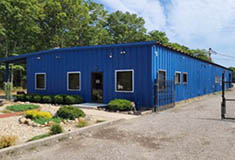News:
Long Island
Posted: May 23, 2011
Stalco Construction completes $30 million project for Three Village Central School District; designed by John A. Grillo, Architect, PC
General contractor Stalco Construction, Inc. and the office of John A. Grillo, Architect, PC completed the extensive, $30 million, 176,000 s/f, multi-phase and multi-site Three Village Central School District's capital improvement program in New York State's Suffolk County on Long Island. The project team also included the structural engineering firm of Eipel Barbieri Marschhausen, LLP (EBM).
The Three Village Central School District undertook the expansion and renovation program aimed at improving the district's facilities, which encompass three high schools and five elementary schools with the total enrollment of approximately 7,600 students.
The district's goals included increasing the number of high school classrooms, expanding the performing arts and athletic facilities, and improving the energy efficiency of the buildings. All additions and expansions meet The Collaborative for High Performance Schools (CHPS) guidelines.
Stalco performed the majority of construction work while the schools were occupied. To ensure the safety of students and staff, the construction team erected extensive safety fences, barricades and temporary walls. Noisy activities and demolitions were performed at nights, on weekends, and during school recesses. Truck deliveries took place at dedicated entrances, inaccessible to students.
The program included ground-up additions and renovations at the Ward Melville High School; P.J. Gelinas Junior High School in Setauket, NY; and R.C. Murphy Junior High School in Stony Brook, NY; as well as renovations to all three high schools and four elementary schools - the Arrowhead Elementary and Nassakeag Elementary in Setauket, Setauket Elementary, and W.S. Mount Elementary in Stony Brook.
The Ward Melville High School additions and expansions encompassed the two-story, 50,000-s/f science wing housing 16 classrooms, 4,000 s/f fitness center, and 6,400 s/f music wing with the 4,000 s/f band and chorus room and 2,400 s/f orchestra room. Renovated areas included the 16,000 s/f auditorium, library, classrooms, hallways, and bathrooms.
Renovations and expansions at both junior high schools were similar in scope and included new 3,000 s/f music wings, seating replacement in auditoriums, new suspended ceilings, and new and renovated masonry partition walls throughout the schools. The new music wings house choir rooms and offices.
The additions feature steel and masonry structural systems and several types of foundations, as schools are located on sites with varying soil conditions. Foundation systems include deep foundation with grade beams and footings extending 9.5 feet down, slabs on grade, and walls with spread footings. The new Ward Melville High School science wing's structural system is designed for a potential addition of the third floor. The gymnasium addition features a curved wall. All additions feature energy-saving Siplast Paradiene 30 CR FR cool roof with a solar reflective index of 91.
Upgrades at the Setauket Elementary included complete renovations to 40 classrooms in the science wing that encompassed new cabinetry, ceilings and VCT flooring; fitness center; and bathrooms. The work at the Arrowhead Elementary included ceiling replacements in the gymnasium and cafeteria. At the Nassakeag Elementary, the crews performed gut renovations to the kitchen, cafeteria, guidance rooms and offices. Stalco also installed a new septic system.
Foundations and structural systems
According to EBM partner Charles Pisano, JR., P.E., "The majority of foundation and structural design challenges were related to joining new and existing structures in a manner that fulfilled requirements of several building codes, including New York State, New York State Education Department, and local and county regulations."
The engineering team also faced design changes due to unexpected field conditions that included pockets of low bearing soil discovered after the excavations had already began.
All building additions are adjacent to the existing structures. The engineering team developed the most interesting solutions at the Ward Melville High School, which received a new fitness center/gymnasium and new music wing.
The music wing features eight steel columns. Four of the columns stand along the exterior perimeter of the new wing and four along the border between the new wing and the original school building. The location of interior columns allowed for creation of a 51-foot clear span within the new band and chorus room that encompasses both the newly built space and the old music room in the existing school building.
EBM designed the foundation and structural system that called for new columns located along the removed exterior wall of the existing building to be situated adjacent to the existing columns of the original building's structure. The corresponding concrete piers and footings for the new columns were also to be constructed adjacent to the existing piers and footings and match their elevation. During excavation, the team discovered that the footings of the original building extended deeper than anticipated. Upon investigation, the engineers established presence of loose material on top of the soil in the area in question. This condition was not present in the nearby areas tested during the project's design phase.
EBM modified the design by extending the piers down and locating footings at the depth of 9 feet 6 inches in order to reach soil with sufficient bearing characteristics. In addition, the dimensions of footings were increased. The new piers and re-bar systems meet ACI (American Concrete Institute) and CRSI (Concrete Reinforcing Steel Institute) specifications.
"The new piers connect to the existing ones with steel dowels inserted into holes drilled in the old piers and filled with Hilti HIT-HY150 Max Fast Cure Hybrid Adhesive. The re-bar cages of new piers were connected with dowels prior to pouring of concrete," said Stalco project manager Joseph Serpe. "The team utilized standard 3,000 psi concrete and 60 ksi (kilopounds per square inch), 5/8-inch diameter re-bars," he added.
In order to achieve the long clear span in the new band room, EBM revised the design of the existing building's section adjacent to the new music wing by adding a massive, 40-inch deep, 52 feet 11 inches long, I-shaped transfer beam above the existing columns. This solution allowed the removal of three old columns to create an uninterrupted performance space as well as transfer of some of the loads of the new building to both new and remaining pre-existing columns below the girder.
The additional loads resulted in replacement of the old pier and footing in the south corner of the structure with a larger one that currently supports both the original column and the new one. The new, 3 feet by 3 feet 6 inches wide, 9 feet 6 inches deep pier features two steel base plates, one for each of the two columns above it. The replacement of the pier required construction of a temporary shoring structure.
The perimeter wall of the new music wing features a foundation wall system with several turns. The longest straight section is 60 feet long.
Unlike the music wing, the Ward Melville High School's new fitness center features masonry block and brick bearing walls, including the 80-foot-long, curved perimeter wall.
The elevation of footings of the pre-existing section adjacent to the fitness center varied from 18 feet and 3 inches to 27 feet and 5 inches, also because of the inconsistent bearing capacity of the soil in the area.
EBM designed a concrete foundation system that combines deep footings, grade beams, and foundation walls with spread footings. The footings of the fitness center in the area immediately adjacent to the original building match the elevation of the existing footings. Geotechnical "area influence" calculations, however, allowed the depth of new footings to decrease with increasing distance from the original structure.
The fitness center's foundation features a total of nine square spread footings outside of the curved wall area. In the sections with poor soil, concrete grade beams located at elevations varying from 12 to 16 feet span the footings. A foundation wall with footings supports the 80-foot-long curved wall section. The 18-inch-thick, seven-foot-deep foundation wall follows the curvature of the wall above. It features footings that are 30 inches wide.
"The re-bar cages for foundation walls arrived at the site pre-fabricated in 24-foot-long sections. The crews cut and bent them to match the design and shape of foundations, including the curved one beneath the fitness center," recalls Stalco Superintendent Richard Feis. "The crews assembled the re-bar cages for piers below columns on-site."
Headquartered in Islandia, NY, with a regional office in New York City, Stalco Construction, Inc. is a full-service general contracting and construction management firm active on Long Island and in the Greater New York area. Established in 1992, the firm builds commercial and institutional facilities for office, retail, educational, healthcare, governmental, cultural, and religious clients. Stalco's personnel include professional engineers, architects, project managers, superintendents, and support staff. The value of the firm's on-going ground-up, interior, and capital improvement projects exceeds $80 million.
Stalco's current and recent work includes the $10-million Battery Park Pier A renovation in Lower Manhattan; the $1.4-million Home Fair store at the Atlas Park Mall in Glendale, NY; Ultra Diamonds jewelry stores in Riverhead, NY; the $11.3-million renovation of the landmarked Erasmus Hall High School in Brooklyn, NY; the on-call Construction Management contract for the 778,000-square foot CA, Inc. Global Headquarters in Islandia, NY; the $1.2-million Dental Hygiene Laboratory and Knapp Hall at SUNY College in Farmingdale, NY; the $30-million expansion and renovation program for the Three Village Central School District in Suffolk County; The Hicksville Fire Department Station 2; and the $2.7-million Holy Sepulchre Cemetery Administrative Building in Coram, NY.
***
Tags:
Long Island
MORE FROM Long Island
Suffolk County IDA supports expansion of A&Z Pharmaceuticals
Hauppauge, NY The Suffolk County Industrial Development Agency (IDA) has granted preliminary approval of a financial incentive package that will assist a manufacturer in expanding its business by manufacturing more prescription (Rx) pharmaceuticals in addition to its existing over-the-counter

Quick Hits
Columns and Thought Leadership

The evolving relationship of environmental consultants and the lending community - by Chuck Merritt
When Environmental Site Assessments (ESA) were first part of commercial real estate risk management, it was the lenders driving this requirement. When a borrower wanted a loan on a property, banks would utilize a list of “Approved Consultants” to order the report on both refinances and purchases.









.jpg)